The aim of this article is to explore how to find the simillimum from the results of the Candegabe Algorithm and to demonstrate how it works with examples from three clients. The algorithm is calculated from the phonetic numerical data or patternings of your client’s name, birthdate and country of origin. One then finds a similar patterning code in the Latin name of a homeopathic remedy.
Keywords Algorithm, New Code, phonetic-numeric code, patterning, simillimum, Candegabe, Huma Method.
Could there be codes other than Hahnemann’s Law of Similars?
Candegabe’s Algorithm is an online diagnostic tool and is a simple, fast and accurate way to determine a client’s simillimum. Samuel Hahnemann discovered that illness was a new orderin the human organism (mind-body). His principle was based on the fundamental Law of Homoeopathy: the Law of Similars, totality of symptoms and individuality, and described what Constantine Hering later called the Law of order of Healing. He used homeopathic symptoms to individualize a case and these symptoms were the key to his method. Later, American James T. Kent enlarged this principle and said that the dynamic illness of human beings was due to the increase of substances (inferior, mineral, vegetable and animal). He said that these substances altered the original order of the human being, modifying his/her perception of reality.
As stated in the Big Bang Theory, living creatures carry the accumulated information from the beginning of creation. Even today modern quantum theories, super gravity theory, cosmic chords and M- Theory, coincide with the fact that we are a kind of converted light and the testimony of what preceded us.
Classical Homoeopathy uses symptoms as the standard information, but there is another standard, The Huma Method, which relates to different substances and illness patterns appearing in clients. The Huma Method proposes a mathematical paradigm, a numerical phonetic code, as a new standard. This method has been proved in over 900 cases using more than 1000 remedies. Over 400 cases cured with the classic method of homoeopathy were analysed as control cases. The numerical phonetic code is calculated from the names and surnames, date of birth, name normally used and country of origin of the client and is the key used to find the simillimum. This key is then correlated with the Latin name of the homeopathic remedy.
The Latin language was applied as the information source because of the International Phonetic Alphabet (AFI, API in French and IPA in English). This method is based on a statistical distribution in order to reach the most precise estimate of probability. There are many homeopaths using the algorithm from all over the world (Italy, USA, UK, Ecuador, Mexico, Brazil, Japan, and Argentina). Jeremy Sherr is applying the algorithm to his epidemic studies. The remedies obtained from the algorithm result are ranked in order from 9 to 2 and indicate the rank or level of mathematical similarity between the substances and the case under analysis. The algorithm also presents a graph called the pregnancy which indicates the most likely substance of the homeopathic remedy, animal, plant or mineral. I use my repertorisaton results from the consultation and compare it with the algorithm result to help me find the medicine for the case.
CASE 1
Female Age: 42
First consultation 28th March, 2007
Presenting Complaint:
MA was going through a difficult period. She felt depressed especially when it was dark, she felt angry and her moods were changeable. She had just finished studying. She had had two children, aged 3 and 5 years. She felt guilty because she wanted to be more bonded with her children and often lost her temper. She had suffered post natal depression for 18 months after each baby and after the first baby she hemorrhaged and was anemic. She had eczema on her hands; warts, insomnia and PMT. She would occasionally have prophetic dreams and couldn’t eat food unless it was very spicy.
Rubrics
Sadness before menses- combined synthesis
Sadness darkness- combined synthesis
Anger easily- combined synthesis
Moods changeable, variable- combined synthesis
Haemorrhage (uterine) -Boenninghausen
Anaemia after hemorrhage – combined synthesis
Warts- combined synthesis
Desire Spices- combined synthesis
Eruption Hand, eczema- combined synthesis
Remedy: Phosphorous 200 for 5 days.
First follow up consultation 15th May, 2007- 2 months later
MA reported she felt better immediately. Her mood was more even; she had no PMT and her sleeping had improved. She was unsure if she liked the career she had chosen to study. Eczema still present but improved 30%.
Remedy: Phosphorous M
Second follow up consultation 7th September 2009- 2 years later
MA reported she had felt well in all ways but in the last couple of months was feeling moody and overwhelmed again. She wanted to be alone; she was depressed and easily irritated with her family. She was sleepless because she felt so angry and was not happy with herself. She felt restricted and didn’t know what she wanted in life. She was still talking about not bonding with her children, so this had not permanently resolved itself on Phosphorous. Her PMT had come back and dreamt of missing a meeting with a friend. There was no eczema on her hand. She was not breastfed. She had noticed her tastes had changed. Previously she could not eat a meal without spices and chili but now she was enjoying more simple food.
Rubrics:
Aversion company > when alone- combined synthesis
Mood changeable- combined synthesis
Antagonism with herself- combined synthesis
Discontented with herself- combined synthesis
Irritability to her family- combined synthesis
Dreams unsuccessful efforts- combined synthesis
The remedy was chosen because of her symptoms, the issue about mothering and not bonding with her children and the result from a new technique called Candgabe’s algorithm . MA’s algorithm indicated she was most likely to be a remedy from the animal kingdom. Lac humanum, a homeopathic remedy made from human milk was the 2nd remedy listed in the algorithm list with a ranking of 9. Lac humanum has issues about mothering. Note that Phosphorous (mineral) was the remedy that helped her initially but had not permanently addressed her issue about mothering. Phosphorous ranked 8 in her algorithm result.
Remedy: Lac humanum 200
Third follow up consultation 8th October 2009- 1 month later
She felt improved the first night although she felt a bit sad for 2 weeks. She is stable in her moods and happy. She is sleeping well. She said she feels confident to be a mother and have a career as well. Since this realization she feels more bonded with her children.
Phone call 10th May /2010- 7 months later
MA had taken 1 more dose of Lac humanum 200 since October and was still feeling happy and well with her children.
Candegabe’s Algorithm for MA The H.U.M.A. Method
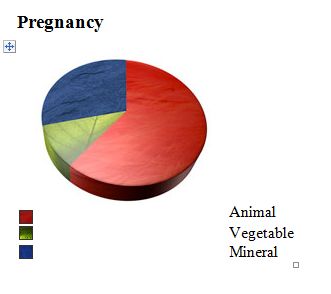
Candegabe’s Algorithm Report
| Kingdom | Remedy RSM (Rango de SemejanzaMatemática) |
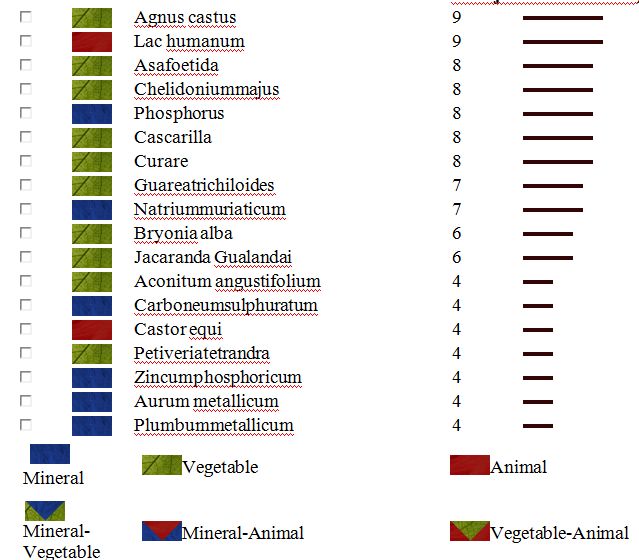
CASE 2
Name : NK Female Age: 47
First Consultation 8th December, 2009
Presenting Complaint
NK was peri-menopausal and had been suffering with night sweats for over 2 years. The flushes suddenly appeared on her face and neck with perspiration. She wakes at 1am feeling wide awake and can’t get back to sleep. She wanted to be a nicer mum and didn’t like being angry and impatient with her 5 year old daughter. Her tongue is cracked and she has been constipated since she was 30 years old. She moves her bowels two days out of seven days. Her last period was in January 2009.
Previously she had endometriosis on the uterus and the bowel and had an operation to remove it before IVF, which wasn’t successful, but she later fell pregnant naturally. She occasionally had sciatica down the right side. She liked sweets, chocolate, cakes and pastry and limits herself to 3-4 cups of coffee per day and used to drink 8-10 cups per day. Her nails have white spots.
Rubrics
Anger easily- combined synthesis
Heat flashes- combined synthesis
Sleeplessness after midnight,1hr – combined synthesis
Pain, lower limbs, sciatica, right – combined synthesis
Food, pastry desire – combined synthesis
Food, coffee desire – combined synthesis
Endometriosis, chronic – combined synthesis
Freckles – combined synthesis
Constipation (in general) – combined synthesis
Spotted nails – combined synthesis
Discoloration, tongue, yellow – combined synthesis
Cracked tongue – combined synthesis
Remedy: Sepia 12c for 14 days
First follow up consultation 9th February, 2010- 1month later
NK’s flushes improved by 75% in a few days. She still has some night sweats which woke her 3 x nightly but she goes to sleep quickly again. She felt she was being a nicer person but still had her angry moments. She was moving her bowels once daily.
Remedy: Sepia 12c for 14 days
Second follow up consultation 9th February, 2010- I month later
NK is feeling very well. Her flushes are completely gone and she is sleeping well. She is moving her bowels every second day. Her tongue is cracked and yellow.
Remedy: Sepia 30c for 7 days
Third follow up consultation 4th May, 2010- 3 months later
NK’s flushes have come back slightly, she only feels a bit warm. She has been a bit wakeful but no night sweats. She was feeling somewhat stressed from work. She was moving her bowels every 2-3 days. Her tongue is still cracked and yellow.
In this consultation she told me she had nose bleeds during pregnancy. I was concerned because her bowels were not permanently improved and her mouth symptoms had not changed. I used different rubrics and compared the repertorisation result with her results from Candegabe’s algorithm to help me find a new medicine for her case. NK’s algorithm indicated she was more likely to be a remedy from the animal kingdom. Crot. Horridus, the homeopathic remedy made from the rattlesnake was chosen because it was the 6th on the algorithm list with a ranking of 8 and because she had a very snappish temper. Sepia, the homeopathic that she responded to in the initial consultations did not appear in her algorithm.
Rubrics
Heat flashes- combined synthesis
Constipation- combined synthesis
Discoloration, tongue, yellow- combined synthesis
Anger, easily- combined synthesis
Epistaxis- combined synthesis
Remedy: Crotalis Horridus 200c for 14 days
Fourth follow up consultation 1st June, 2010- 1 month later
Her skin was extremely itchy for 2 days and nights and she had worse problems with the constipation after the remedy. She was now moving her bowels every day without straining. She felt very happy and not stressed even though she had been very busy at work. She said she was not worrying about her financial situation anymore. She also had a normal period. Her tongue was a lot better with only a small amount of yellow at the back. She still has tiny cracks across her tongue but they are less than at the last consultation.
Remedy: no remedy but she was instructed to repeat Crotalis horridus 200c if there was any setback with her symptoms.
Phone call 14th July 2010– She still is very well and has not repeated the remedy.
Case 3
Female Age 18 months
First Consultation: 5thJanuary, 2010
Presenting Complaint:
CE had cramp-like pains when she sat in her high chair when eating. During the cramp, which extended across her stomach and abdomen, she would bend backward and go into a trance like state. She had a strong appetite and had chapped skin on the back of her hands.
Rubrics
Trance- Combined Synthesis
Pain, cramping, abdomen, bending backward amel
Pain, abdomen, Digestion, During- Combined Synthesis
Chaps Hands: fingers: backs of –Boenninghausen
Contraction, Stomach- Combined Synthesis
Pain, cramping (griping), abdomen- Combined Synthesis
Pain, extending across- Combined Synthesis
Appetite increased (hunger in general)- Combined Synthesis
Remedy: Dioscorea villosa 30c for 7 days
First follow up consultation: 9th February 2010
CE was worse after the Dioscorea villosa 30c and then went back to how she was when she came for the visit. I then compared the results of the repertorisation with CE’s result from Candegabe’s Algorithm. The algorithm (see attached Chart) indicated she was more likely to be a mineral remedy, so I chose Cuprum aceticum, the 7th remedy with a ranking of 6 from her algorithm.
Remedy: Cuprum aceticum 200c for 7 days
Second follow up consultation: 27th April 2010
She was much improved and only had the cramping very occasionally.
Remedy: Cuprum Aceticum 200 for 7 days
Third follow up phone call: 14th July 2010
No cramping and CE is very well.
Jan Scholten talks about the time he was asked to treat the Dakota Indians during a sun dance ritual. The dancers didn’t eat or drink anything during the trance so they could be in contact with the spirits. During this time they developed cramps. Cuprum aceticum alleviated the cramps in the Indians. There was no rubric that included trance under Cuprum aceticum but it is interesting to note that CE would be in a trance like state when she was feeling the cramps in her abdomen just like the Dakota Indians. Ritual, like the sun dance of the Dakota Indians and hardship are the concepts of Cuprum aceticum.
Discussion
At present classical homoeopathy is limited by the enormous amount of new remedies and numerous new symptoms discovered in recent research. After the clinical history of your patient is taken by means of classical homeopathy so that you can establish their dynamic disease, you can enter your patient’s relevant information needed for the Huma Method in order to obtain their algorithm analysis. The Huma Method can make it easier for the homeopath to make a better remedy choice and will bring up remedies to consider which normally wouldn’t be in their thoughts.
There is a free demo version of the Candegabe Algorithm at: http://www.algoritmocandegabe.com/index.php?lang=en
References
- http://www.universidadcandegabe.org, AlgoritmoCandegabeMetoda HUMA, Candegabe M, 2010, 20th July, 2010
- Scholten J, 1996, Homoeopathy and the Elements, StichtingAlonnissos, Utrecht,The Netherlands, pp 448-450


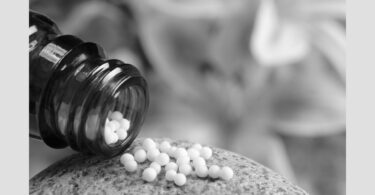
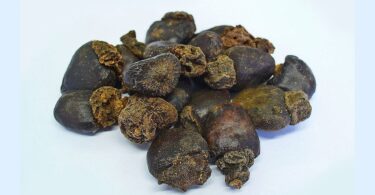
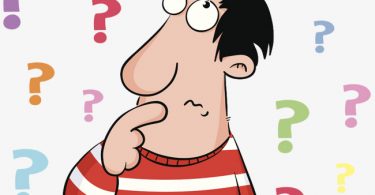
This. Article is quite interesting. I will be grateful to the author if she can give me some more web sites on algorimocandegabe. Thanks. For her efforts
Go to http://www.algoritmocandegabe.com/index.php?lang=en and watch the demo and watch the interview
Also you could go to my Facebook page on homeopathy and the algorithm https://www.facebook.com/homeopathyalgorithm
If you would like to try one free sample of the algorithm email me at [email protected]
Good luck
The algorithm is an exciting tool and has expanded my knowledge of homeopathy.